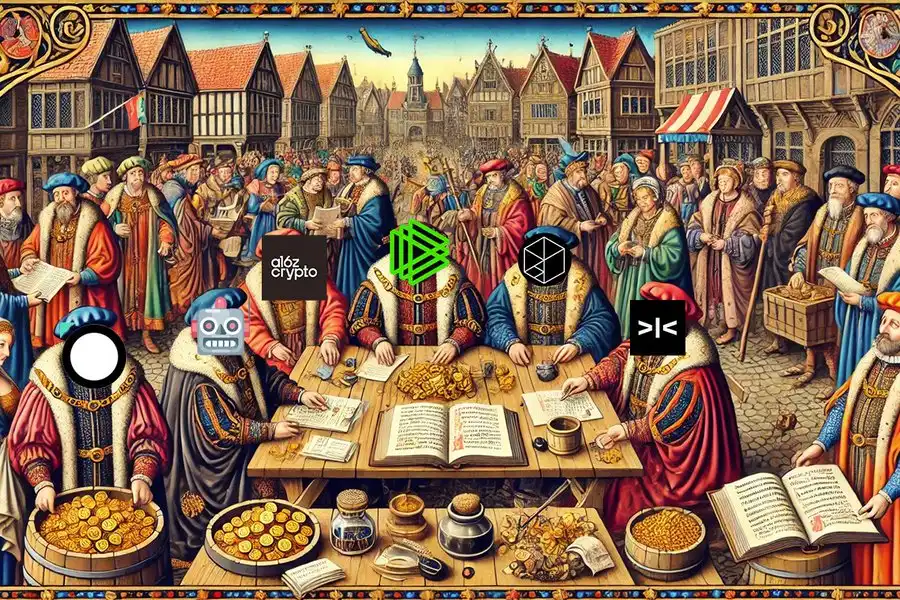Original Title: Tale of Two Tokens: What Ethena and HyperLiquid Teach Us
Original Author: DiogenesCasares, Crypto Kol
Original Compiler: zhouzhou, BlockBeats
Editor's Note: Although HyperLiquid and Ethena have adopted different financing and token strategies, both have successfully executed their respective product visions. HyperLiquid focuses on decentralized derivatives, while Ethena has rapidly grown into a leading stablecoin protocol. Both have made decisions aligned with product development by understanding user needs and dynamically adjusting strategies. The key to success lies in guiding decisions based on a clear vision and belief, rather than a "one-size-fits-all" approach.
The following is the original content (reorganized for readability):
In the weeks following its initial release, HyperLiquid became one of the top 20 tokens (if calculated by FDV), achieving this without relying on any major centralized exchange listings. Its supporters are primarily traders and users, whose trust in the product resembles that of BeReal/Instagram fans, rather than the "traditional" crypto finance groups like Link Marines.
The HYPE airdrop had (too few) conditions attached, which indeed made many people wealthy, but many chose not to sell, believing in the project. I think this is one of the core differences between HyperLiquid and many other current projects: people believe in HyperLiquid's vision and trust that they will profit.
This sacred symbiotic relationship between vision, execution, and fundamentals may be unique to HyperLiquid, but it can also be seen to some extent in other highly profitable and widely followed DeFi projects this year, such as Ethena Labs.
This article will explore the similarities between Ethena and HyperliquidX, both of which are building core products widely used by local users, and will analyze their differences to help readers understand the factors that enable systems to succeed.
Laying the Foundation: Product

Creating a good product is always challenging, but in the crypto space, there is a strange mentality that good products are "unachievable," or that there is no product-market fit (PMF), or that it "isn't big enough," or "someone has already done it." These are all fallacies.
One of the biggest criticisms of Ethena is that what it does has been attempted by decentralized protocols like UXD. However, Ethena differentiated itself by leveraging custodial access to centralized liquidity to solve liquidity issues and gain yields from underlying stETH/re-staked assets. This is a relatively small adjustment, but it gives Ethena's product scalability and stability. Additionally, by using USDe and sUSDe, which are almost equivalent to the relationship between ETH and stETH, Ethena's yield is naturally higher than if it executed the strategy independently.
HyperLiquid is not the first decentralized derivatives platform, far from it. However, HyperLiquid has innovated in speed (very fast deposit processing), liquidity (HLP), and distribution (vaults). HyperLiquid's trading platform is highly reliable, with almost no crashes, while competitors' systems have experienced outages lasting hours or even days, with one platform even facing a block reorganization (reorg), forcing it to ask users via Google Forms how much they lost.
This poor user experience has also troubled liquidity providers and traders, who never know if they can deposit or withdraw smoothly. HyperLiquid has eliminated this issue, thereby winning user trust and support.
Building Process: Distribution and Execution

Both Ethena and HyperLiquid have great products, but that doesn't mean people will automatically find them. So, how do you get people to test the products and improve them? In the cases of Ethena and HyperLiquid, the answer is: communicate with as many people as possible.
On my anonymous account, the Ethena team actually reached out to me when their TVL had not yet reached $20 million. At that time, I needed to deposit by signing a contract and locking funds for a certain period, in exchange for a fixed minimum yield, which I ultimately did not do (of course, that was a big mistake). However, I greatly admire one aspect of the Ethena team: their ability to leverage "other people's networks" (OPNs).
Seraphim (MacroMate8) is a master in this regard. I was contacted by dcfgod, one of the best angel investors in this field, who reached out to me, as well as the templedao team, other RFV traders, and large traders—basically his entire network.
For DCF God, this was fantastic because he believed in the product and the team, so these referrals were very helpful to people in his network. At the same time, this was extremely useful for Ethena, which is why they allowed him to participate as an angel investor. This is also reflected in CryptoHayes's involvement, who may be one of the best storytellers and one of the best platforms for communicating with users, and he just happens to invest as well.
In the case of HyperLiquid, Jeff and other team members cast a wide net. They reached out to everyone from HsakaTrades to my RFV trading friend burstingbagel. They tried to get as many people as possible to join the platform and began building the products needed by the community, including ultimately helping to create the vaults that generate HLP, allowing HyperLiquid to have deep liquidity without market makers, avoiding the high costs typically associated with market maker liquidity trading on DEXs. This direct relationship between the product's users and the HyperLiquid team makes users feel heard, important, and part of the project, rather than just external observers.
Maintaining Control: Moats and Network Effects

All excellent projects will spawn imitators or competitors, such as Ondo with OpenEden, Eigenlayer with Symbiotic, and similar examples abound with Morpho and Euler, Aptos and Sui, etc. However, truly outstanding projects can identify and solidify their own "moats," thereby strengthening product advantages and enhancing competitiveness.
Take stETH/Lido as an example; it is clearly the market leader, even though theoretically, its underlying product is replicable. Running validation nodes, earning yields for users, and creating a wrapped token are not difficult. However, what is difficult to replicate or compete with is the vast liquidity that stETH possesses and its deep integration with lending protocols and the broader DeFi ecosystem.
These moats make users more inclined to use stETH, even if theoretically, the yields may be slightly lower compared to competitors, because they can use stETH in DeFi. Ethena has replicated this model, focusing on funding rate arbitrage. It has integrated with almost all major protocols in ETH DeFi, as well as an increasing number of centralized exchanges. The moats Ethena has built in liquidity, acceptability/composability, and large-scale high yields provide users with a range of functionalities, greatly enhancing user loyalty.
For HyperLiquid, liquidity itself is its core moat. HyperLiquid's HLP is designed to provide users with high-quality liquidity, allowing new markets to grow while ensuring that users always have a last buyer/seller guarantee. The more users there are, the better the pricing, which attracts more users, and this positive cycle further strengthens the platform's position.
To solidify its dominance, HyperLiquid is allowing projects to build on an independent, EVM-compatible chain that can interact with HyperLiquid's spot/derivative positions. This will provide traders with more seamless and capital-efficient market-making and neutral hedging strategies while increasing user functionalities, further reinforcing its market position.
Theoretically, HyperLiquid could be forked after being open-sourced, but the forked version would not have HLP, all users, or liquidity. Even if it is an excellent product, the key to long-term survival lies in establishing and solidifying moats. This is why, even though Ethena and HyperLiquid have nearly complete dominance in their respective markets, they continue to strengthen their moats.
Divergence: Funding Pathways and Airdrops

This section is where significant differences between Ethena and HyperLiquid begin to emerge, and these differences are not just stylistic but also substantively very different. Ethena's product provides liquidity access for hedging neutral yields, while HyperLiquid's product is a decentralized derivatives protocol.
Due to its model, Ethena must rely on existing platforms to achieve scalability, and a good way to ensure this is by obtaining investments from exchanges to incentivize them. In contrast, HyperLiquid's goal is to replace these exchanges; it does not intend to collaborate with them, so it does not need to rely on them.
The HyperLiquid team is known for its high-frequency trading (HFT) capabilities and does not need to raise capital. While the Ethena team itself is also very successful, they have not earned the tens of millions of dollars that may be needed to build Ethena, ensuring its long-term survival and allowing it to focus entirely on the product without having to consider profitability.
Theoretically, Ethena could have chosen not to raise funds, but by financing, they were able to increase their chances of success. From a game theory perspective, especially from a financial standpoint, people tend to trust those 1) teams with rich experience in specific fields (like HyperLiquid) or 2) teams that have strong endorsements/support from authoritative figures.
While the Ethena team is excellent, they do not have the same reputation as the HyperLiquid team in understanding exchange infrastructure (a core component of high-frequency trading) when it comes to managing neutral hedging trades. Ethena's acquisition of investments from these big players is not only to gain social support to accelerate their growth but also to pave the way for eventual protocol integration, which may be the best decision for their specific product.
HyperLiquid decided not to raise funds, taking on the risk of covering HyperLiquid's operating costs, with the aim of conducting larger-scale airdrops and avoiding systemic sell-offs (like those from VCs). This decision is likely the best choice they made based on their product characteristics, as their goal is to compete with most existing exchanges and even hope to replace them.
Ethena's ENA airdrop was also very successful, with larger holders being forced to hold for a longer time, while retail users faced no such strict restrictions, cleverly using remilios to garner community support for Ethena.
Nevertheless, its response was far less than that of the HYPE airdrop, which had almost no additional conditions and did not set a vesting period for larger accounts. HyperLiquid effectively restricted the recipients of the airdrop, prioritizing larger accounts that might benefit from "airdrop farming," although they received only a small portion of the initial value, these tokens would be fully unlocked after the airdrop.
Ethena's point system is also very clear, aimed at guiding user behavior, while HyperLiquid's system seems arbitrary. Although it disproportionately rewards high-volume traders/market makers and liquidated users, it lacks a clear formula.
Conclusion: Path Dependence

My conclusion is that I believe this is a very important point, even though I have not seen it in any articles about HyperLiquid's success. HyperLiquid has done an excellent job in executing its vision and product path.
Ethena has also executed its product vision impeccably, becoming the fastest-growing stablecoin protocol. They have adopted completely different approaches to token and capital raising, but their decisions are based on a belief in their development path and a clear vision of the final product.
There is no "one-size-fits-all" way to manage airdrops and token economics; they are dynamic equations that must be adjusted with an understanding of your product's context and user needs. If you can achieve this, and your decisions reflect the ideal path that best suits your product, then you can achieve success.
免责声明:本文章仅代表作者个人观点,不代表本平台的立场和观点。本文章仅供信息分享,不构成对任何人的任何投资建议。用户与作者之间的任何争议,与本平台无关。如网页中刊载的文章或图片涉及侵权,请提供相关的权利证明和身份证明发送邮件到support@aicoin.com,本平台相关工作人员将会进行核查。




